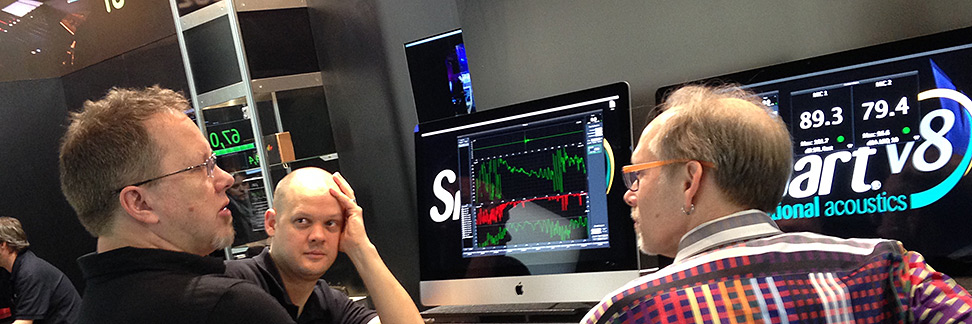By Bob McCarthy
"The development of this book spans more than thirty years in the field of sound system optimization. Were it not for the discoveries and support of John and Helen Meyer, I would have never become involved in this field. They have committed substantial resources to this effort, which have directly helped the ongoing research and development leading up to this writing. In addition, I would like to acknowledge the contribution of every client who gave me the opportunity to perform my experiments on their sound systems. Each of these experiences yielded an education that could not be duplicated elsewhere. In particular I would like to thank David Andrews, Peter Ballenger, Nick Baybak, Mark Belkie, Mike Brown, Andrew Bruce, John Cardenale, Tom Clark, Mike Cooper, Jonathan Deans, François Desjardin, Steve Devine, Martin Van Dijk, Steve Dubuc, Duncan Edwards, Aurellia Faustina, T. C. Furlong, Roger Gans, Scott Gledhill, Michael Hamilton, Andrew Hope, Abe Jacob, Akio Kawada, Andrew Keister, Tony Meola, Ben Moore, Philip Murphy, Kevin Owens, Frank Pimiskern, Bill Platt, Marvic Ramos, Harley Richardson, Paul Schmitz, David Sarabiman, Pete Savel, Rod Sintow, Bob Snelgrove, David Starck, Benny Suherman, Leo Tanzil and Geoff Zink, all of whom have given me multiple opportunities through the years to refine the methods described here. Special thanks to Mr O at the National Theatre of Korea, Mr Song at Dongseo University, Mr Lee and others at the LG Art Center.
I have also learned much from other engineers who share my passion for this field of work and constantly challenge me with new ideas and techniques. This list would be endless and includes but is not limited to Brian Bolly, Michael Creason, Ales Dravinec, Josh Evans, Peter Grubb, Glenn Hatch, Luke Jenks, Miguel Lourtie, Karoly Molnar, John Monitto, Matt Salerno, John Scandrett and Robert Scovill.
I would also like to thank Meyer Sound for sponsoring my seminars and to Gavin Canaan and others for organizing them. I am grateful to everyone who has attended my seminars, as the real-time feedback in that context provides a constant intellectual challenge and stimulation for me. My fellow instructors in this field have contributed much collaborative effort through discussion and the sharing of ideas. Notable among these are Jamie Anderson, Oscar Barrientos, Timo Beckman, Sam Berkow, Harry Brill, Richard Bugg, Steve Bush, Jim Cousins, Pepe Ferrer, Michael Hack, Mauricio Ramirez, Arthur Skudrow, Hiro Tomioka, Merlijn Van Veen and Jim Woods.
Thanks to Daniel Lundberg for his creation of the uncoupled array calculator based on data from my previous edition. This tool is a mainstay of my design process.
A huge majority of the knowledge, data (and graphics) in this book comes from two sources: Meyer Sound’s SIM3 Audio Analyzer and their MAPP Online™ platform. I would have nothing to write about without these tools. My gratitude goes to everyone who contributed to their creation, including (but not limited to) John and Helen Meyer, Perrin Meyer, Dr Roger Schwenke, Fred Weed, Todd Meier, Mark Schmeider, Paul Kohut and the late Jim Isom.
The following figures contain data from my earlier publications at Meyer Sound and their permission is gratefully acknowledged: Figures 3.9, 4.24, 4.27, 13.12 to 13.16. The data presented in Figures 1.1, 1.4, 1.11 and 12.11 were created using the calculations by Mauricio Ramirez. The 3-D wraparound graphics (Figure 12.8) were adapted from the animations created by Greg Linhares. Merlijn Van Veen contributed a mix of core calculations, data and graphics that went into the construction of Figures 1.12, 2.2, 2.5 to 2.12, 3.30, 3.37, 3.42, 4.8, 8.11, 8.14 and 14.10. John Huntington contributed some of the photographs used in the section break pages, specifically Section 1 (panels 1, 5 and 7) and Section 3 (panel 4).
Thanks go to all of the people who aided in the process of bringing this edition to physical reality such as my editor Megan Ball and Mary LaMacchia at Focal Press. Additional thanks go to Margo Crouppen for her support throughout the entire publishing process.
I received proofing and technical help for my previous editions from Jamie Anderson, Sam Berkow, David Clark, John Huntington, Mauricio Ramirez and Alexander (Thorny) Yuill-Thornton. Harry Brill Jr., Richard Bugg, Philip Duncan, John Huntington, Jeff Koftinoff and Mauricio Ramirez contributed to the third edition.
Merlijn Van Veen deserves special recognition for his enormous contributions to this edition. He hung with me at every step of the way, pushing me to clarify language, methodology and backing up my calculations. He also contributed greatly to the graphics, providing both material support and advice on how to best convey the information. I learned much from Merlijn in the course of this writing and his mark has clearly been left in these pages.
Finally, there is no one who comes close to contributing as much support as my wife Merridith. She has read every page and seen every drawing of every edition and been absolutely tireless in her efforts. Each edition has been an endurance test lasting over a year and she has stuck with me through each, swayed by my promises that this would be the last one (fooled her again). This book would not have been possible without her support as my agent, manager, copy editor, proofreader and cheerleader."
Sound Systems: Design and Optimization 3rd Edition by Bob McCarthy is published by Focal Press - Routledge.
